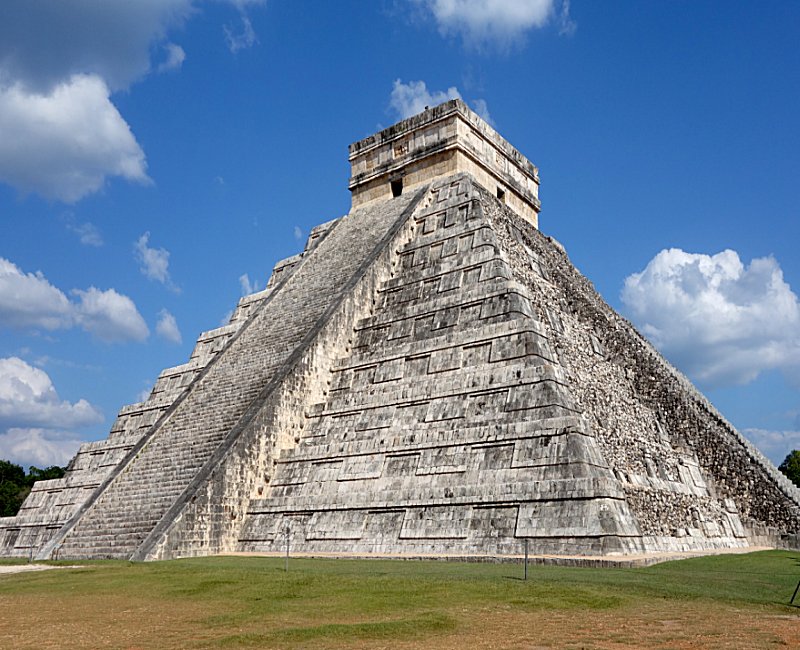Impressive Pyramid Of Kukulkan (El Castillo’) At Chichen Itza
A. Sutherland - AncientPages.com - The largest and most important structure of Chichen Itza is the KukulcanTemple (also known as ‘The Castle’ – El Castillo). It is the legacy of the Toltec overlords, whose culture had a profound influence on Chichen Itza.
Westside of the Temple of Kukulcan. Image credit: Luka Peternel - CC BY-SA 4.0
Chichen Itza, located in the north of the Yucatan Peninsula near the city of Valladolid, in Mexico, was one of the most important centers of the Mayan culture. It was founded about the sixth century, probably by the Maya peoples of the Yucatán Peninsula.
Impressive Pyramid Temple was dedicated to the Feathered Serpent, Quetzalcoatl (known among the Maya people as Kukulcan); this deity, ever-present at Chichen Itza, is of Central Mexican origin and assumed a distinguished position in the pantheons of Teotihuacan and Toltec Tula.
While it is relatively small, it has become one of the most famous pyramids in the world. This is due to the huge elegance, which ensured its symmetry making it even more beautiful.
The pyramid was built in the second half of the eleventh century or in the middle of the twelfth century. Interestingly, in its interior archaeologists discovered the remains of a similar pyramid built about a hundred years earlier.
It has a square base with sides of length 55 m (181 ft) and a height of 30 m (99 ft) and it is, therefore, very small compared to the pyramid of Cheops at Giza or the Pyramid of the Sun in Teotihuacan, Mexico.
Each side of the structure’s four sides has 91 steps, leading to the temple on top; along with the temple platform on top as the final “step”, totally 365 steps – the number of days in the solar year.
Nine terraces decorated with a meander motif, probably symbolize the writhing snake. On either side of each stairway, the terraces, which make 18 on each face of the pyramid; this equals the number of months in the Maya solar year (each month consisting of 20 days). On the sloping vertical faces of these terraces are 52 empty panels, representing the 52-year Calendar Round cycle required to bring the two Maya calendars.
Researchers used 3D imaging techniques to discover the structure, hidden beneath outer layers at the pyramid of Kukulkan at the Mayan ruins of Chichen Itza.
One of them is the heavenly (solar) 365-day calendar and another, the earthly, 260-day calendar related to rituals, which was most probably derived from the 9-month period of human gestation — into alignment.
Recently, researchers announced the discovery of a 10 m pyramid 10 meters tall (33 feet) inside two other structures that make up the pyramid also known as El Castillo, or the Castle.
During earlier archaeological diggings in the 1930s had already revealed one structure inside the pyramid containing a red jaguar throne decorated with jade.
A. Sutherland - AncientPages.com
More From Ancient Pages
-
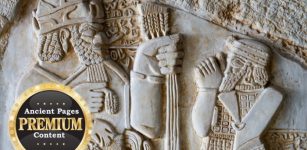 Odd Ancient Dwellings Of The Snake People – Clues From Biblical Lands – Part 2
Biblical Mysteries | Sep 10, 2020
Odd Ancient Dwellings Of The Snake People – Clues From Biblical Lands – Part 2
Biblical Mysteries | Sep 10, 2020 -
 Illuminati: Facts And History About The Secret Society
Featured Stories | Mar 30, 2017
Illuminati: Facts And History About The Secret Society
Featured Stories | Mar 30, 2017 -
 Lost Ancient Pyramid City As Big As Manhattan Discovered In Mexico
Archaeology | Feb 17, 2018
Lost Ancient Pyramid City As Big As Manhattan Discovered In Mexico
Archaeology | Feb 17, 2018 -
 Forgotten Ancient Empire That Extended Far Beyond America To Iceland And Its Mysterious Inscriptions
Featured Stories | May 6, 2021
Forgotten Ancient Empire That Extended Far Beyond America To Iceland And Its Mysterious Inscriptions
Featured Stories | May 6, 2021 -
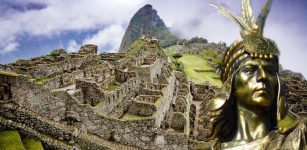 The Inca Empire Was Powerful And Well-Organized – Why Were They So Successful?
Ancient History Facts | Sep 21, 2020
The Inca Empire Was Powerful And Well-Organized – Why Were They So Successful?
Ancient History Facts | Sep 21, 2020 -
 Perfectly Preserved Roman Tombs Discovered Near City Of Capua Where Spartacus Trained As Gladiator
Archaeology | Jan 7, 2021
Perfectly Preserved Roman Tombs Discovered Near City Of Capua Where Spartacus Trained As Gladiator
Archaeology | Jan 7, 2021 -
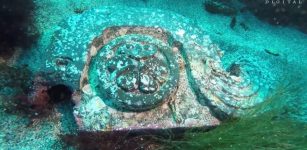 Underwater Robot Investigates Edo Period Decorative Tiles Off Shizuoka, Japan
Archaeology | Dec 7, 2015
Underwater Robot Investigates Edo Period Decorative Tiles Off Shizuoka, Japan
Archaeology | Dec 7, 2015 -
 On This Day In History: Treaty of Bergerac Ratified – On Sep 17, 1577
News | Sep 17, 2016
On This Day In History: Treaty of Bergerac Ratified – On Sep 17, 1577
News | Sep 17, 2016 -
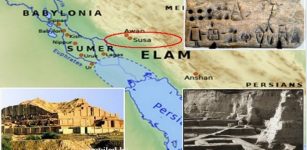 Riddle Of Two Undeciphered Elamite Scripts
Featured Stories | May 19, 2021
Riddle Of Two Undeciphered Elamite Scripts
Featured Stories | May 19, 2021 -
 Why Are Medieval Manuscripts Full Of Doodles Of Snail Fights?
Featured Stories | Jun 17, 2023
Why Are Medieval Manuscripts Full Of Doodles Of Snail Fights?
Featured Stories | Jun 17, 2023 -
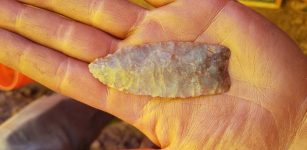 Evidence Americas’ Oldest Mine In Wyoming Was Used By Paleoindians 13,000 Years Ago Has Been Found!
Archaeology | May 19, 2022
Evidence Americas’ Oldest Mine In Wyoming Was Used By Paleoindians 13,000 Years Ago Has Been Found!
Archaeology | May 19, 2022 -
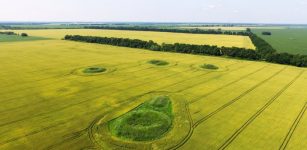 Bezvodovka: Little Known Ancient Solar Observatory In Ukraine Reveals Its Secrets
Archaeoastronomy | Jan 4, 2017
Bezvodovka: Little Known Ancient Solar Observatory In Ukraine Reveals Its Secrets
Archaeoastronomy | Jan 4, 2017 -
 Curly Hair Protected The Brain Of Early Humans And Helped It Grow
Human Beginnings | Aug 31, 2023
Curly Hair Protected The Brain Of Early Humans And Helped It Grow
Human Beginnings | Aug 31, 2023 -
 What Was Legio Martia And Why Were The Roman Soldiers Called The Martians?
Ancient History Facts | Jan 5, 2018
What Was Legio Martia And Why Were The Roman Soldiers Called The Martians?
Ancient History Facts | Jan 5, 2018 -
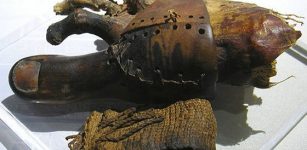 Prehistoric Evidence Of Sophisticated Prosthetics In Ancient Egypt – Artificial Toes Helped Egyptians Walk
Archaeology | Feb 20, 2014
Prehistoric Evidence Of Sophisticated Prosthetics In Ancient Egypt – Artificial Toes Helped Egyptians Walk
Archaeology | Feb 20, 2014 -
 On This Day In History: Battle Of Pinkie Was Fought – On September 10, 1547
News | Sep 10, 2016
On This Day In History: Battle Of Pinkie Was Fought – On September 10, 1547
News | Sep 10, 2016 -
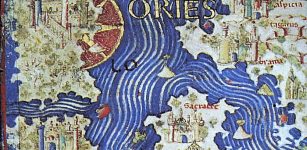 Fra Mauro Medieval Map: Accurate And Detailed Work Attesting To Advanced Geographic Knowledge Of Contemporary Cartographers
Artifacts | Feb 8, 2019
Fra Mauro Medieval Map: Accurate And Detailed Work Attesting To Advanced Geographic Knowledge Of Contemporary Cartographers
Artifacts | Feb 8, 2019 -
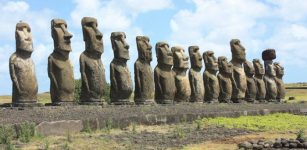 New Attempt To Solve The Easter Island Mystery – What Did Rapa Nui Look Like Before Europeans Arrived?
Archaeology | Sep 20, 2017
New Attempt To Solve The Easter Island Mystery – What Did Rapa Nui Look Like Before Europeans Arrived?
Archaeology | Sep 20, 2017 -
 Unusual 6,000-Year-Old Gold Objects Discovered In Hungarian Tombs – More Mysterious Conical Hats?
Archaeology | Mar 25, 2021
Unusual 6,000-Year-Old Gold Objects Discovered In Hungarian Tombs – More Mysterious Conical Hats?
Archaeology | Mar 25, 2021 -
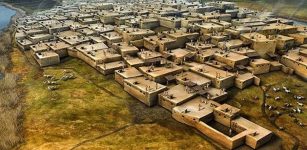 Fascinating Neolithic Society Based On Equality – Catalhoyuk, Turkey
Civilizations | Sep 18, 2015
Fascinating Neolithic Society Based On Equality – Catalhoyuk, Turkey
Civilizations | Sep 18, 2015

